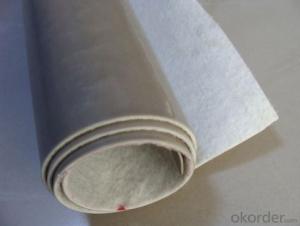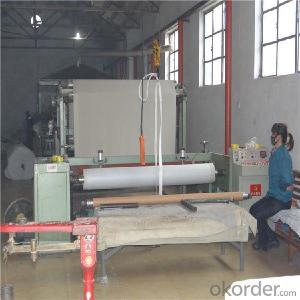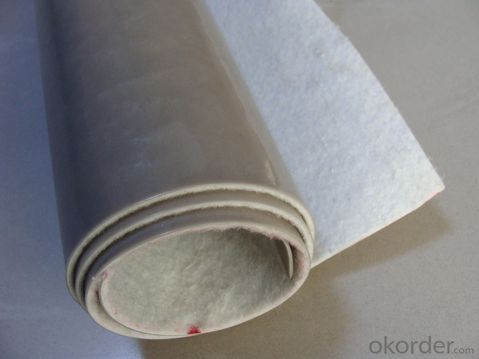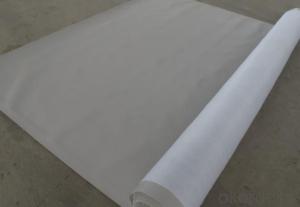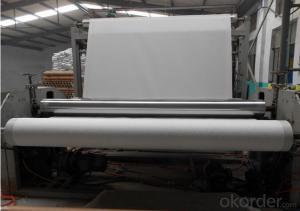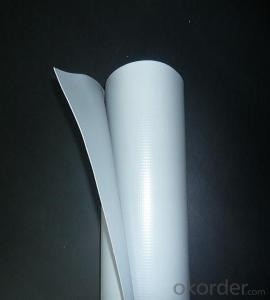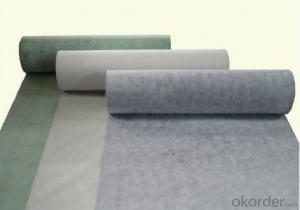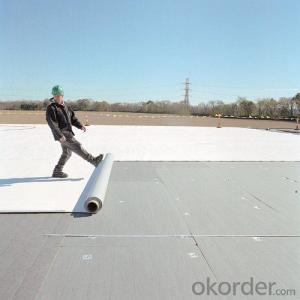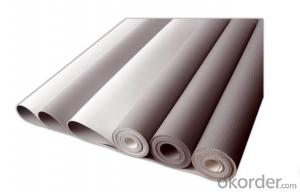Polyvinyl Chloride (PVC) Waterproofing Membrane of Best Quality
- Loading Port:
- China main port
- Payment Terms:
- TT OR LC
- Min Order Qty:
- 5000 m²
- Supply Capability:
- 100000 m²/month
OKorder Service Pledge
OKorder Financial Service
You Might Also Like
1. Introduction of PVC Waterproofing Membrane
Polyvinyl Chloride (PVC) waterproof membrane is a new polymer waterproof membrane which is made from polyvinyl chloride resin, and mixed with plasticizer, filler, antioxygen, ultraviolet absorber and other auxiliaries.
2. Features of PVC Waterproofing Membrane
1) Excellent aging resistance. Service life of roofing material is over 20 years;
service life of underground material is over 50 years.
2) Root resistant penetration, specially used on planting roof.
3) Welding installation. Joints are solid and environment friendly, no pollution.
4) High tensile strength, good elongation and dimensional stability.
5) Good plasticity, easy and suitable for details installation.
6) Fireproof. Fire extinguished out of the ignition resource.
7) Surface is smooth, no fading and dirty resistant.
3. Specification of PVC Waterproofing Membrane
Length | 20m/roll or customized |
Width | 2.05m |
Thickness | 1.2mm; 1.5mm; 2.0mm |
Type | Homogeneous, Reinforced, Fabric back |
If Exposed | Exposed and Non-exposed |
Color | White, Grey or customized |
4. Types of PVC Waterproofing Membrane
N1—Exposed PVC waterproof membrane.
(It is mainly used as details treatment for exposed roof waterproof project)
N2—Non-exposed PVC waterproof membrane.
(It is mainly used as details treatment for non-exposed roof waterproof project)
L1—Exposed PVC waterproof membrane with fabric.
(It is mainly used for exposed roof waterproof project)
L2—Non-exposed PVC waterproof membrane with fabric.
(It is mainly used for non-exposed roof waterproof project)
W1—Exposed reinforced PVC waterproof membrane .
(It is mainly used for steel structure roof exposed waterproof project)
W2—Exposed reinforced PVC waterproof membrane .
(It is mainly used for steel structure roof non-exposed waterproof project)
5. FAQ of PVC Waterproofing Membrane
a.Can we get some samples before place order?
Answer: We can send the free samples to you by freight collect.
b.How many years can your PVC membrane guarantee?
Answer: We will guarantee the quality for 5 years at least.
c.Which countries you ever export the product?
Answer: We export the PVC membrane to South Africa, Middle east and even European countries.
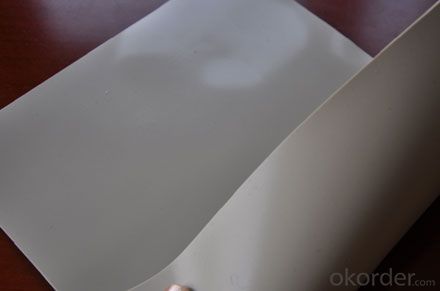
- Q: Can a waterproofing membrane be used in areas with high foot traffic?
- Yes, a waterproofing membrane can be used in areas with high foot traffic. Waterproofing membranes are designed to provide a protective barrier against water and moisture, making them suitable for various environments, including areas with heavy foot traffic. These membranes are commonly used in commercial buildings, such as shopping malls, hospitals, and office complexes, where foot traffic is frequent. However, it is important to choose the right type of waterproofing membrane that is specifically designed for high foot traffic areas. Some membranes are more durable and resistant to wear and tear, making them ideal for such environments. Additionally, proper installation and maintenance of the membrane are crucial to ensure its longevity and effectiveness in high foot traffic areas. Furthermore, it is worth considering the specific requirements of the area and consulting with professionals or manufacturers to determine the most suitable waterproofing membrane for the given conditions. Overall, with the right selection and proper installation, a waterproofing membrane can effectively protect areas with high foot traffic from water damage and ensure their longevity.
- Q: Are waterproofing membranes suitable for historical buildings?
- Under certain circumstances, historical buildings can benefit from the use of waterproofing membranes. These membranes are specifically designed to safeguard structures against water damage, which is especially important for historical buildings that may have aged and porous materials. However, the suitability of waterproofing membranes for historical buildings relies on a variety of factors. First and foremost, it is vital to take into account the unique requirements and characteristics of the historical building in question. Each building possesses distinct materials and features, and the impact of waterproofing on these elements must be thoroughly assessed. Some older structures may possess delicate architectural elements or materials that could be adversely influenced by the application of waterproofing membranes. In such instances, alternative methods that are less intrusive or damaging may be more appropriate. Secondly, it is essential to seek guidance from conservation experts or professionals who specialize in the preservation of historical buildings. These experts can evaluate the specific needs of the building and offer advice on the most suitable waterproofing techniques. They can also ensure that any interventions are executed in a manner that respects the historical integrity and authenticity of the structure. Lastly, it is crucial to consider the long-term consequences of waterproofing membranes on historical buildings. While these membranes can effectively protect against water damage, they may also compromise the natural breathability of the building, potentially leading to moisture accumulation and further deterioration. Therefore, it is imperative to carefully balance the benefits of waterproofing with the potential risks and long-term effects. In conclusion, while waterproofing membranes can be appropriate for historical buildings, caution should be exercised when applying them. A thorough assessment of the building's specific requirements, consultation with preservation experts, and consideration of long-term implications are essential in determining the suitability of waterproofing membranes for historical structures.
- Q: Does a waterproofing membrane require any specific surface preparation for tile installations?
- Yes, a waterproofing membrane does require specific surface preparation for tile installations. The success of the waterproofing membrane and the longevity of the tile installation depend on proper surface preparation. Before installing a waterproofing membrane, it is crucial to ensure that the surface is clean, dry, and free from any contaminants such as dust, debris, oil, grease, or any loose or crumbling materials. The surface should be thoroughly cleaned and any existing tile, adhesive, or grout should be removed if necessary. In addition to cleanliness, it is important to make sure the surface is smooth and even. Any uneven areas or imperfections should be leveled and patched using a suitable patching compound. This will help prevent any water from pooling or seeping underneath the waterproofing membrane, which could lead to potential issues such as leaks, mold growth, or damage to the tile installation. Furthermore, it is essential to ensure that the surface is structurally sound and stable. If there are any cracks, weak areas, or signs of instability, they should be addressed and repaired before installing the waterproofing membrane. This will help provide a solid foundation for the tile installation and prevent any future problems. Overall, proper surface preparation is crucial for the success of a waterproofing membrane and tile installation. It ensures a clean, smooth, and stable surface, which is necessary for the membrane to adhere properly and provide effective waterproofing. Following the manufacturer's guidelines and consulting with a professional if needed can help ensure the correct surface preparation for a long-lasting and reliable tile installation.
- Q: Can waterproofing membranes be used on underground structures?
- Indeed, underground structures can make use of waterproofing membranes. These membranes have been designed with the aim of creating a barrier against water infiltration and are widely utilized in various applications, including basements, tunnels, and underground parking lots. The main objective of employing waterproofing membranes in underground structures is to avert water penetration, as this can lead to structural damage and compromise stability. Generally, these membranes are crafted from materials like modified bitumen, PVC, EPDM, or HDPE, all of which possess outstanding water resistance properties. By applying waterproofing membranes correctly, a continuous and robust barrier is established, preventing water from seeping through the walls, floors, or foundations of underground structures. These membranes can be installed externally or, on occasion, as an integral part of the concrete walls or floors during construction. In addition to their water resistance capabilities, waterproofing membranes also offer protection against other elements such as chemicals, gases, and radon. They prove highly effective in preventing issues related to moisture, like the growth of mold, the deterioration of building materials, and structural damage, thus ensuring the durability and integrity of underground structures. It is crucial to bear in mind that the proper installation and maintenance of waterproofing membranes are of utmost importance for their effectiveness. It is advisable to engage the services of a qualified professional who can assess the specific requirements of the underground structure and recommend the appropriate type of waterproofing membrane and installation method. All in all, waterproofing membranes serve as a dependable and efficient solution for preventing water infiltration in underground structures, providing long-lasting protection and preserving the structural integrity of the building.
- Q: Can a waterproofing membrane be used for elevator pits and sump pits?
- Yes, a waterproofing membrane can be used for elevator pits and sump pits. Elevator pits and sump pits are generally prone to water leakage and moisture issues, which can cause damage to the structural integrity of the pits and surrounding areas. To prevent such issues, waterproofing membranes are commonly used to create a barrier against water intrusion. A waterproofing membrane is designed to be highly resistant to water penetration and can effectively seal the elevator and sump pits, preventing water from seeping in. These membranes are typically made of materials such as rubberized asphalt, ethylene propylene diene terpolymer (EPDM), or polyvinyl chloride (PVC) and are applied to the walls and floors of the pits. By installing a waterproofing membrane, the elevator and sump pits can be protected from water damage, including potential corrosion, mold growth, and structural deterioration. This not only helps to maintain the functionality and longevity of the pits but also ensures a safe and healthy environment for occupants and equipment. However, it is important to consider the specific requirements and regulations of elevator and sump pit installations, as different jurisdictions may have specific codes and standards that need to be followed. Additionally, proper installation and regular maintenance of the waterproofing membrane are crucial to ensure its effectiveness in preventing water infiltration.
- Q: Can a waterproofing membrane be used on modified bitumen roofs?
- A waterproofing membrane is capable of being utilized on modified bitumen roofs. In fact, it is quite customary to apply a waterproofing membrane on top of modified bitumen roofs in order to provide an extra layer of defense against water infiltration. This is particularly crucial in regions where heavy rainfall occurs or where the roof is frequently exposed to water. The waterproofing membrane serves to seal any potential cracks or openings in the modified bitumen roofing system, thereby preventing water from penetrating and causing damage to the underlying structure. Moreover, the waterproofing membrane can also bolster the overall durability and longevity of the roof by shielding it from the detrimental effects of moisture.
- Q: What is waterproofing membrane?
- Waterproof membrane is mainly used for building walls, roofs, as well as tunnels, highways, landfills, etc., to resist the external rain, groundwater leakage can be curled into a roll of flexible building materials, as the basis for engineering And no leakage between the building connection, the entire project is the first waterproof barrier, the entire project plays a vital role. The main products are asphalt waterproofing membrane and polymer waterproofing membrane.
- Q: Can a waterproofing membrane be used for foundation walls?
- Yes, a waterproofing membrane can be used for foundation walls. Waterproofing membranes are commonly used to protect foundation walls from moisture, preventing water penetration and potential damage to the structure. These membranes are designed to create a protective barrier against water, helping to keep the foundation dry and maintaining its structural integrity.
- Q: Can a waterproofing membrane be used on precast cement board surfaces?
- Yes, a waterproofing membrane can be used on precast cement board surfaces. The membrane acts as a protective barrier against water infiltration and helps to prevent damage to the cement board.
- Q: Can a waterproofing membrane be exposed to sunlight?
- Certainly, sunlight poses no problem for a waterproofing membrane. In reality, numerous waterproofing membranes are engineered to endure extended exposure to sunlight without any degradation or loss of efficacy. Nevertheless, it is vital to acknowledge that not all waterproofing membranes possess equal resistance to UV rays, hence it is crucial to select a membrane explicitly designed for outdoor applications and capable of withstanding sunlight exposure. Furthermore, it is always advisable to adhere to the manufacturer's instructions and guidelines pertaining to the particular waterproofing membrane being utilized, in order to guarantee its longevity and optimal performance.
Send your message to us
Polyvinyl Chloride (PVC) Waterproofing Membrane of Best Quality
- Loading Port:
- China main port
- Payment Terms:
- TT OR LC
- Min Order Qty:
- 5000 m²
- Supply Capability:
- 100000 m²/month
OKorder Service Pledge
OKorder Financial Service
Similar products
Hot products
Hot Searches
Related keywords
